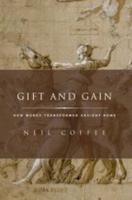
OUP (2017) h/b 296pp £47.99 (ISBN 9780190496432)
C.’s argument is that from the middle Republic to the early Principate Rome developed from a culture of reciprocal, or even altruistic, gift-giving to one of commercial considerations which treated gifts as contracts. He admits that the ideology, and even practice (e.g. Atticus), of gift-giving persisted, and claims that Augustus tried to revive it. He also concedes that some historians might argue that there had always been a tension between ‘gift’ and ‘gain’ at Rome. He claims, however, to provide proof of this development in the form of statistical studies of the frequency of key words in the main extant Latin authors of the period.
The words for ‘greed’ (fig. 4.1), for instance, rise markedly in the late Republic, he says, and attest increasing concern about the commercialisation of social exchange. Frequency is calculated as the percentage of an author’s total word use as drawn from the Packard Humanities Institute textual database of Latin authors. For example, of the 428 attestations of avaritia and cognates in the main authors, 135 are in Cicero but form only 0.01% of his usage, whereas Sallust’s 30 cases make his usage by far the highest of any Latin author at almost 0.07%. Latinists may feel this tells us more about Sallust than the late Republic. They may be suspicious too of the claim that a decline in the adverb liberaliter (fig. 5.1) as against a rise in the noun liberalitas (unsurprisingly peaking in the self-basting younger Pliny) show, on the etymological analogy of the Italian liberalmente, a change from attitude to performance.
Given the small variation in the percentages of use, a statistician might wish to test the supposed trends for significance (R2 coefficient). The chapters on each period typically focus on a couple of authors, and take their assertions at face value. Historians may feel this book is more about elite literary discourse than Roman behaviour. The claim that lucrum (fig. 7.2) developed negative connotations in the late Republic ignores non-elite inscriptions and indeed Phaedrus (its peak user). C. baldly says he doesn’t like Bourdieu (social capital) and he doesn’t like Marx. All very well, but there are other ways (such as asymmetric reciprocity) of treating patronage, which C. flags here and there as crucial in Roman life, but never discusses. Indeed his whole treatment of the historical background is thin and cavalier, and the dozy OUP readers have left a treasure hunt of factual errors, such as (p.48) the Samnite envoys (c. 290 BC) finding the elder Cato boiling turnips (after their 100-year trip?).
Yes, Republican Rome became a more ‘commercialised’ society—see P. Kay, Rome’s Economic Revolution (2014)—but what we really want to know is how this, and also political change, affected patronage, the principal form of gift-giving throughout Roman society.
Dominic Rathbone
